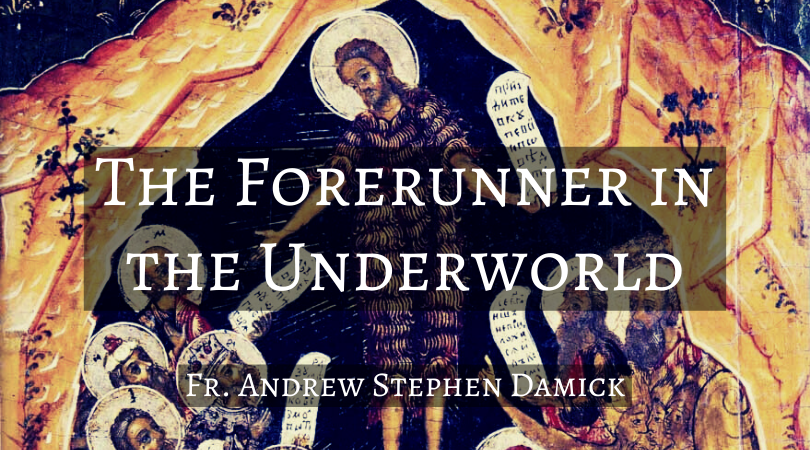
Beheading of the Forerunner, August 29, 2020
Acts 13:25-33; Mark 6:14-30
In the Name of the Father and of the Son and of the Holy Spirit, one God. Amen.
Today we celebrate the feast of the Beheading of the Forerunner and Baptist John. And so I want to talk about the journey of St. John the Forerunner into Hades.
In the apolytikion for this feast, we sing:
After suffering with joy in behalf of the truth, thou didst proclaim even to those in Hades the God Who appeared in the flesh, Who taketh away the sin of the world, and granteth us Great Mercy.
And in the kontakion for the feast, we hear:
The beheading of the glorious Forerunner was by divine providence, that the coming of the Savior might be preached to those in Hades.
This theme is repeated over and over in the services for this feast.
It may come as a surprise to many Christians that the Church teaches that St. John not only journeyed into Hades, the underworld or the place of the dead, but he went there to preach Christ.
This teaching is not spelled out in so many words in the Scripture, of course, but there are indications there that this is so. 1 Peter 4:6, for instance, says “the gospel was preached also to those who are dead.”
And it was fitting that the Forerunner should be the one to do it, for according to Ephesians 4:9-10, Christ Himself descended into Hades, and 1 Peter 3:19 says that Christ went to Hades and preached to the formerly disobedient spirits imprisoned there. So even into Hades itself St. John was sent on ahead to preach the gospel before the coming of the Lord.
What is going on here? What does it mean that St. John went into Hades? That Christ went there? Where even is Hades? Why preach to those there?
In order to understand this teaching of the Church, let’s begin with the underworld itself, also called Hades or Hell, depending on the translation.
The Underworld
If you know some Greek mythology, you know that Hades is the name given to the underworld, the place of the dead. In that place, the dead lead a kind of shadowy, disembodied existence, not truly alive. In some cases, they are actively being tormented with fire in Tartarus, while others may enjoy the Elysian Fields, which are not exactly “heaven.”
To be in the Elysian Fields was still to live as a shade, a shadow of one’s former self. It is a gloomy, hopeless place, and no one in Greek paganism ever considered the possibility that once someone died, they would ever get out. A handful of people in history might have the chance of becoming gods and therefore never be sent to Hades.
If you know Greek mythology a little better, you know that Hades is also the name of the god who controlled the underworld, the lord of the dead. So to be in Hades the place was also to be in the control of Hades the person.
It is for this reason, by the way, that I disagree with those who say that Hades is a better term for our English translations concerning the place of the dead than Hell. Hell is simply the Germanic name for both the place and also the god who ruled it, while Hades comes from Greek. Conceptually, they are interchangeable, even if some people associate Hell mainly with the part of Hades that the Greeks called Tartarus. Either way, modern notions of the place of the dead are so muddled that we have to teach about them to set the record straight, no matter which word we might use.
The Hebrew term for this place is Sheol, which literally means “the grave.” It does not refer merely to a hole in the ground, however, but truly to the place of the dead, the underworld.
Spiritual Geography
Yet why do we call it “the underworld”? Does this mean that Hades is somewhere underground, that if we dig long enough, we might bump into the shades of the dead or even the god of the dead? Bear with me here, because this also takes some explaining.
Ancient peoples understood sacred, spiritual geography as not being identical with the material geography we normally think of. So if you were to ask whether you could dig to Hades, that would be nonsense. Likewise, you cannot fly high enough that you could reach Heaven. Spiritual geography rather overlays material geography, with both present together depending on the spiritual participation of those involved.
To give but one example: Where is the Mountain of the Lord? In Genesis, it is in the Paradise of Eden. In Exodus, it is on Sinai. It is also Mount Horeb and Mount Zion and Mount Tabor. Were the ancient Israelites just confused about where God lived and met with them? No, they understood that the spiritual Mountain of the Lord could be present on various material mountains. And even in our own time, we may also add Mount Athos.
The underworld of the dead is therefore present both in an inaccessible way to us who are alive in the sense that we can’t just dig to get there but also in an accessible way to us when we are, for instance, at a tomb and praying for the dead. Various places in the ancient world were also understood to be gateways to the underworld, and they almost always were places associated with death and burial.
As I said, the underworld was understood to be the domain of the god of the dead, variously called Hades, Hel or in some Ancient Near East religion, Baal, who was a storm god whose kingdom had its foundations in the underworld.
We need to understand this in order to understand why Christ descended into Hades and even preached in Hades and also why the Forerunner went and preached there before Him.
Him Who Had the Power of Death
One of the things that the Scripture says about the demon we call the devil is that he had “the power of death” (Heb. 2:14). When he was cast down from God’s council of the angelic hosts, the only power left to him was the power of death. And when Christ died on the Cross—a feast for which we are now preparing and will celebrate on September 14—He journeyed into Hades and destroyed even that last power of the devil, the power of death.
And He arose on the third day—which we will celebrate in two weeks on September 13 with the commemoration of the consecration of the Church of the Resurrection—an arising which scattered His enemies and threw down all the false gods of the nations from their thrones.
Thus, the descent of Christ into Hades was a descent to expel the demons, especially the devil, even from the realm of death and even to undo its power entirely. And who are these spirits imprisoned there to whom He preached? They are the demons who had afflicted the earth before the Great Flood of Noah (1 Peter 3:19-20). Christ’s confrontation with demons is a key element of what the gospel actually is.
If we think that the gospel is merely a kind of spiritual sales pitch to get people to believe in Jesus, then we misunderstand it. The gospel is a declaration that the Lord of Life, the Son and Word of God, has thrown down death and defeated all His enemies—the demons, the false gods of the nations—and is retaking the Creation which is His own. It is an invasion, a reconquest of what is His.
Now we understand why Christ preached even to demons and why St. John was sent to the underworld to preach. It is not because they were there on a mission to try to convert people to a religion called Christianity. Rather, it is an assault on Hades itself, and St. John is the messenger sent before the face of the Lord to proclaim His coming, to give a warning both on earth and in the underworld.
Redeem My Soul from the Power of Sheol
To the ancient pagan, a shadowy existence in the Elysian Fields of Hades, subject to the demonic lord of the dead, was the very best that he could hope for after death. But the people of God had been given a hope from the beginning, a hope expressed in such Psalms as those of the Sons of Korah (Ps. 42-49, 84-85, 87-88), which include such lines as Psalm 49:15: “But God will redeem my soul from the power of Sheol.”
The confrontation with the demons of death by the Son and Word of God is key to understanding the whole Scripture and of course the very gospel itself. The gospel is the announcement that He is coming, that He is coming to destroy His enemies, to destroy even death itself, the last enemy (1 Cor. 15:26).
The Forerunner, therefore, having announced Christ’s coming to those on earth, is beheaded now and sent to preach even in Hades, announcing His coming even to that place. And his shout rings throughout the underworld, warning that the Lord of Life is coming to break open the gates of death, throw down the lord of death from his throne, and to release those who lie in hope in the underworld.
Thus, in the Eighth Ode of the Canon for this feast, we sing:
He that came from barrenness as the forerunner to the Virgin Birth, now, through the cutting off of his head, is become the pathfinder for the voluntary Crucifixion of Him that created all things; and unto those in Hades he crieth out: O ye dead, supremely exalt the Giver of Life; ye blind, the Giver of Light; ye captives, the Deliverer, even Christ.
To the Giver of Life, our Lord Jesus Christ therefore be all glory, honor and worship, with His Father and the Holy Spirit, now and ever, and unto ages of ages. Amen.


